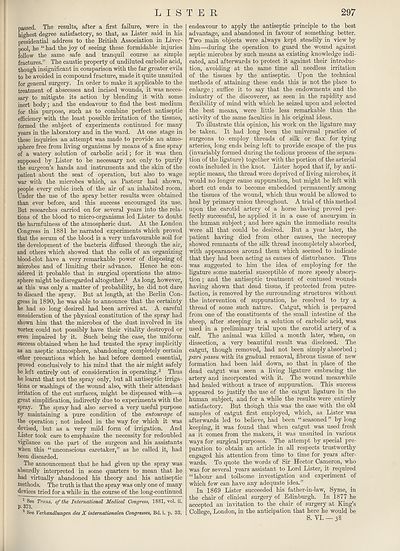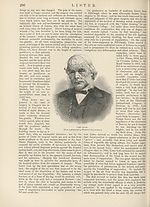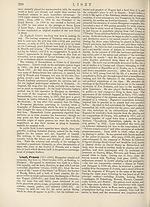New volumes of the Encyclopædia Britannica > Volume 30, K-MOR
(327) Page 297
Download files
Complete book:
Individual page:
Thumbnail gallery: Grid view | List view

LIS
passed. The results, after a first failure, were in the
highest degree satisfactory, so that, as Lister said in his
presidential address to the British Association in Liver¬
pool, he “had the joy of seeing these formidable injuries
follow the same safe and tranquil course as simple
fractures.” The caustic property of undiluted carbolic acid,
though insignificant in comparison with the far greater evils
to be avoided in compound fracture, made it quite unsuited
for general surgery. In order to make it applicable to the
treatment of abscesses and incised wounds, it was neces¬
sary to mitigate its action by blending it with some
inert body; and the endeavour to find the best medium
for this purpose, such as to combine perfect antiseptic
efficiency with the least possible irritation of the tissues,
formed the subject of experiments continued for many
years in the laboratory and in the ward. At one stage in
these inquiries an attempt was made to provide an atmo¬
sphere free from living organisms by means of a fine spray
of a watery solution of carbolic acid; for it was then
supposed by Lister to be necessary not only to purify
the surgeon’s hands and instruments and the skin of the
patient about the seat of operation, but also to wage
war with the microbes which, as Pasteur had shown,
people every cubic inch of the air of an inhabited room.
Under the use of the spray better results were obtained
than ever before, and this success encouraged its use.
But researches carried on for several years into the rela¬
tions of the blood to micro-organisms led Lister to doubt
the harmfulness of the atmospheric dust. At the London
Congress in 1881 he narrated experiments which proved
that the serum of the blood is a very unfavourable soil for
the development of the bacteria diffused through the air,
and others which showed that the cells of an organizing
blood-clot have a very remarkable power of disposing of
microbes and of limiting their advance. Hence he con¬
sidered it probable that in surgical operations the atmo¬
sphere might be disregarded altogether.1 As long, however,
as this was only a matter of probability, he did not dare
to discard the spray. But at length, at the Berlin Con¬
gress in 1890, he was able to announce that the certainty
he had so long desired had been arrived at. A careful
consideration of the physical constitution of the spray had
shown him that the microbes of the dust involved in its
vortex could not possibly have their vitality destroyed or
even impaired by it. Such being the case, the uniform
success obtained when he had trusted the spray implicitly
as an aseptic atmosphere, abandoning completely certain
other precautions which he had before deemed essential,
proved conclusively to his mind that the air might safely
be left entirely out of consideration in operating.2 Thus
he learnt that not the spray only, but all antiseptic irriga¬
tions or washings of the wound also, with their attendant
irritation of the cut surfaces, might be dispensed with—a
great simplification, indirectly due to experiments with the
spray. The spray had also served a very useful purpose
by maintaining a pure condition of the entourage of
the operation; not indeed in the way for which it was
devised, but as a very mild form of irrigation. And
Lister took care to emphasize the necessity for redoubled
vigilance on the part of the surgeon and his assistants
when this “unconscious caretaker,” as he called it, had
been discarded.
The announcement that he had given up the spray was
absurdly interpreted in some quarters to mean that he
had virtually abandoned his theory and his antiseptic
methods. The truth is that the spray was only one of many
devices tried for a while in the course of the long-continued
1 See Trans, of the International Medical Congress, 1881, vol. ii.
p. 373.
2 See Verhandlungen des X internationalen Congresses, Bd. i. p. 33.
TER 297
endeavour to apply the antiseptic principle to the best
advantage, and abandoned in favour of something better.
Two main objects were always kept steadily in view by
him—during the operation to guard the wound against
septic microbes by such means as existing knowledge indi¬
cated, and afterwards to protect it against their introduc¬
tion, avoiding at the same time all needless irritation
of the tissues by the antiseptic. Upon the technical
methods of attaining these ends this is not the place to
enlarge; suffice it to say that the endowments and the
industry of the discoverer, as seen in the rapidity and
flexibility of mind with which he seized upon and selected
the best means, were little less remarkable than the
activity of the same faculties in his original ideas.
To illustrate this opinion, his work on the ligature may
be taken. It had long been the universal practice of
surgeons to employ threads of silk or flax for tying
arteries, long ends being left to provide escape of the pus
(invariably formed during the tedious process of the separa¬
tion of the ligature) together with the portion of the arterial
coats included in the knot. Lister hoped that if, by anti¬
septic means, the thread were deprived of living microbes, it
would no longer cause suppuration, but might be left with
short cut ends to become embedded permanently among
the tissues of the wound, which thus would be allowed to
heal by primary union throughout. A trial of this method
upon the carotid artery of a horse having proved per¬
fectly successful, he applied it in a case of aneurysm in
the human subject; and here again the immediate results
were all that could be desired. But a year later, the
patient having died from other causes, the necropsy
showed remnants of the silk thread incompletely absorbed,
with appearances around them which seemed to indicate
that they had been acting as causes of disturbance. Thus
was suggested to him the idea of employing for the
ligature some material susceptible of more speedy absorp¬
tion ; and the antiseptic treatment of contused wounds
having shown that dead tissue, if protected from putre¬
faction, is removed by the surrounding structures without
the intervention of suppuration, he resolved to try a
thread of some such nature. Catgut, which is prepared
from one of the constituents of the small intestine of the
sheep, after steeping in a solution of carbolic acid, was
used in a preliminary trial upon the carotid artery of a
calf. The animal was killed a month later, when, on
dissection, a very beautiful result was disclosed. The
catgut, though removed, had not been simply absorbed ;
pari passu with its gradual removal, fibrous tissue of new
formation had been laid down, so that in place of the
dead catgut was seen a living ligature embracing the
artery and incorporated with it. The wound meanwhile
had healed without a trace of suppuration. This success
appeared to justify the use of the catgut ligature in the
human subject, and for a while the results were entirely
satisfactory. But though this was the case with the old
samples of catgut first employed, which, as Lister was
afterwards led to believe, had been “seasoned” by long
keeping, it was found that when catgut was used fresh
as it comes from the makers, it was unsuited in various
ways for surgical purposes. The attempt by special pre¬
paration to obtain an article in all respects trustworthy
engaged his attention from time to time for years after¬
wards. To quote the words of Sir Hector Cameron, who
was for several years assistant to Lord Lister, it required
“labour and toilsome investigation and experiment of
which few can have any adequate idea.”
In 1869 Lister succeeded his father-in-law, Syme, in
the chair of clinical surgery of Edinburgh. In 1877 he
accepted an invitation to the chair of surgery at King’s
College, London, in the anticipation that here he would be
g. yi. _ 38
passed. The results, after a first failure, were in the
highest degree satisfactory, so that, as Lister said in his
presidential address to the British Association in Liver¬
pool, he “had the joy of seeing these formidable injuries
follow the same safe and tranquil course as simple
fractures.” The caustic property of undiluted carbolic acid,
though insignificant in comparison with the far greater evils
to be avoided in compound fracture, made it quite unsuited
for general surgery. In order to make it applicable to the
treatment of abscesses and incised wounds, it was neces¬
sary to mitigate its action by blending it with some
inert body; and the endeavour to find the best medium
for this purpose, such as to combine perfect antiseptic
efficiency with the least possible irritation of the tissues,
formed the subject of experiments continued for many
years in the laboratory and in the ward. At one stage in
these inquiries an attempt was made to provide an atmo¬
sphere free from living organisms by means of a fine spray
of a watery solution of carbolic acid; for it was then
supposed by Lister to be necessary not only to purify
the surgeon’s hands and instruments and the skin of the
patient about the seat of operation, but also to wage
war with the microbes which, as Pasteur had shown,
people every cubic inch of the air of an inhabited room.
Under the use of the spray better results were obtained
than ever before, and this success encouraged its use.
But researches carried on for several years into the rela¬
tions of the blood to micro-organisms led Lister to doubt
the harmfulness of the atmospheric dust. At the London
Congress in 1881 he narrated experiments which proved
that the serum of the blood is a very unfavourable soil for
the development of the bacteria diffused through the air,
and others which showed that the cells of an organizing
blood-clot have a very remarkable power of disposing of
microbes and of limiting their advance. Hence he con¬
sidered it probable that in surgical operations the atmo¬
sphere might be disregarded altogether.1 As long, however,
as this was only a matter of probability, he did not dare
to discard the spray. But at length, at the Berlin Con¬
gress in 1890, he was able to announce that the certainty
he had so long desired had been arrived at. A careful
consideration of the physical constitution of the spray had
shown him that the microbes of the dust involved in its
vortex could not possibly have their vitality destroyed or
even impaired by it. Such being the case, the uniform
success obtained when he had trusted the spray implicitly
as an aseptic atmosphere, abandoning completely certain
other precautions which he had before deemed essential,
proved conclusively to his mind that the air might safely
be left entirely out of consideration in operating.2 Thus
he learnt that not the spray only, but all antiseptic irriga¬
tions or washings of the wound also, with their attendant
irritation of the cut surfaces, might be dispensed with—a
great simplification, indirectly due to experiments with the
spray. The spray had also served a very useful purpose
by maintaining a pure condition of the entourage of
the operation; not indeed in the way for which it was
devised, but as a very mild form of irrigation. And
Lister took care to emphasize the necessity for redoubled
vigilance on the part of the surgeon and his assistants
when this “unconscious caretaker,” as he called it, had
been discarded.
The announcement that he had given up the spray was
absurdly interpreted in some quarters to mean that he
had virtually abandoned his theory and his antiseptic
methods. The truth is that the spray was only one of many
devices tried for a while in the course of the long-continued
1 See Trans, of the International Medical Congress, 1881, vol. ii.
p. 373.
2 See Verhandlungen des X internationalen Congresses, Bd. i. p. 33.
TER 297
endeavour to apply the antiseptic principle to the best
advantage, and abandoned in favour of something better.
Two main objects were always kept steadily in view by
him—during the operation to guard the wound against
septic microbes by such means as existing knowledge indi¬
cated, and afterwards to protect it against their introduc¬
tion, avoiding at the same time all needless irritation
of the tissues by the antiseptic. Upon the technical
methods of attaining these ends this is not the place to
enlarge; suffice it to say that the endowments and the
industry of the discoverer, as seen in the rapidity and
flexibility of mind with which he seized upon and selected
the best means, were little less remarkable than the
activity of the same faculties in his original ideas.
To illustrate this opinion, his work on the ligature may
be taken. It had long been the universal practice of
surgeons to employ threads of silk or flax for tying
arteries, long ends being left to provide escape of the pus
(invariably formed during the tedious process of the separa¬
tion of the ligature) together with the portion of the arterial
coats included in the knot. Lister hoped that if, by anti¬
septic means, the thread were deprived of living microbes, it
would no longer cause suppuration, but might be left with
short cut ends to become embedded permanently among
the tissues of the wound, which thus would be allowed to
heal by primary union throughout. A trial of this method
upon the carotid artery of a horse having proved per¬
fectly successful, he applied it in a case of aneurysm in
the human subject; and here again the immediate results
were all that could be desired. But a year later, the
patient having died from other causes, the necropsy
showed remnants of the silk thread incompletely absorbed,
with appearances around them which seemed to indicate
that they had been acting as causes of disturbance. Thus
was suggested to him the idea of employing for the
ligature some material susceptible of more speedy absorp¬
tion ; and the antiseptic treatment of contused wounds
having shown that dead tissue, if protected from putre¬
faction, is removed by the surrounding structures without
the intervention of suppuration, he resolved to try a
thread of some such nature. Catgut, which is prepared
from one of the constituents of the small intestine of the
sheep, after steeping in a solution of carbolic acid, was
used in a preliminary trial upon the carotid artery of a
calf. The animal was killed a month later, when, on
dissection, a very beautiful result was disclosed. The
catgut, though removed, had not been simply absorbed ;
pari passu with its gradual removal, fibrous tissue of new
formation had been laid down, so that in place of the
dead catgut was seen a living ligature embracing the
artery and incorporated with it. The wound meanwhile
had healed without a trace of suppuration. This success
appeared to justify the use of the catgut ligature in the
human subject, and for a while the results were entirely
satisfactory. But though this was the case with the old
samples of catgut first employed, which, as Lister was
afterwards led to believe, had been “seasoned” by long
keeping, it was found that when catgut was used fresh
as it comes from the makers, it was unsuited in various
ways for surgical purposes. The attempt by special pre¬
paration to obtain an article in all respects trustworthy
engaged his attention from time to time for years after¬
wards. To quote the words of Sir Hector Cameron, who
was for several years assistant to Lord Lister, it required
“labour and toilsome investigation and experiment of
which few can have any adequate idea.”
In 1869 Lister succeeded his father-in-law, Syme, in
the chair of clinical surgery of Edinburgh. In 1877 he
accepted an invitation to the chair of surgery at King’s
College, London, in the anticipation that here he would be
g. yi. _ 38
Set display mode to:
![]() Universal Viewer |
Universal Viewer | ![]() Mirador |
Large image | Transcription
Mirador |
Large image | Transcription
Images and transcriptions on this page, including medium image downloads, may be used under the Creative Commons Attribution 4.0 International Licence unless otherwise stated. ![]()
| Encyclopaedia Britannica > New volumes of the Encyclopædia Britannica > Volume 30, K-MOR > (327) Page 297 |
|---|
| Permanent URL | https://digital.nls.uk/193571752 |
|---|
| Attribution and copyright: |
|
|---|---|
| Shelfmark | EB.18 |
|---|---|
| Description | Ten editions of 'Encyclopaedia Britannica', issued from 1768-1903, in 231 volumes. Originally issued in 100 weekly parts (3 volumes) between 1768 and 1771 by publishers: Colin Macfarquhar and Andrew Bell (Edinburgh); editor: William Smellie: engraver: Andrew Bell. Expanded editions in the 19th century featured more volumes and contributions from leading experts in their fields. Managed and published in Edinburgh up to the 9th edition (25 volumes, from 1875-1889); the 10th edition (1902-1903) re-issued the 9th edition, with 11 supplementary volumes. |
|---|---|
| Additional NLS resources: |
|

